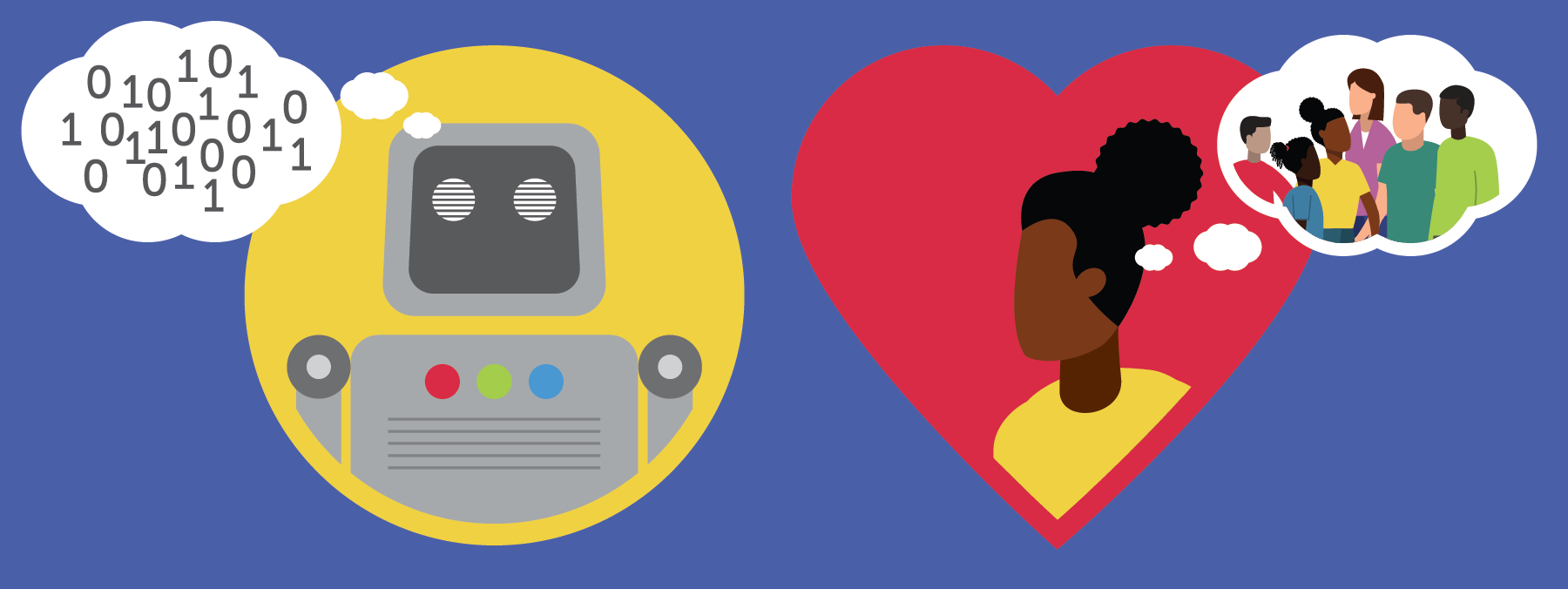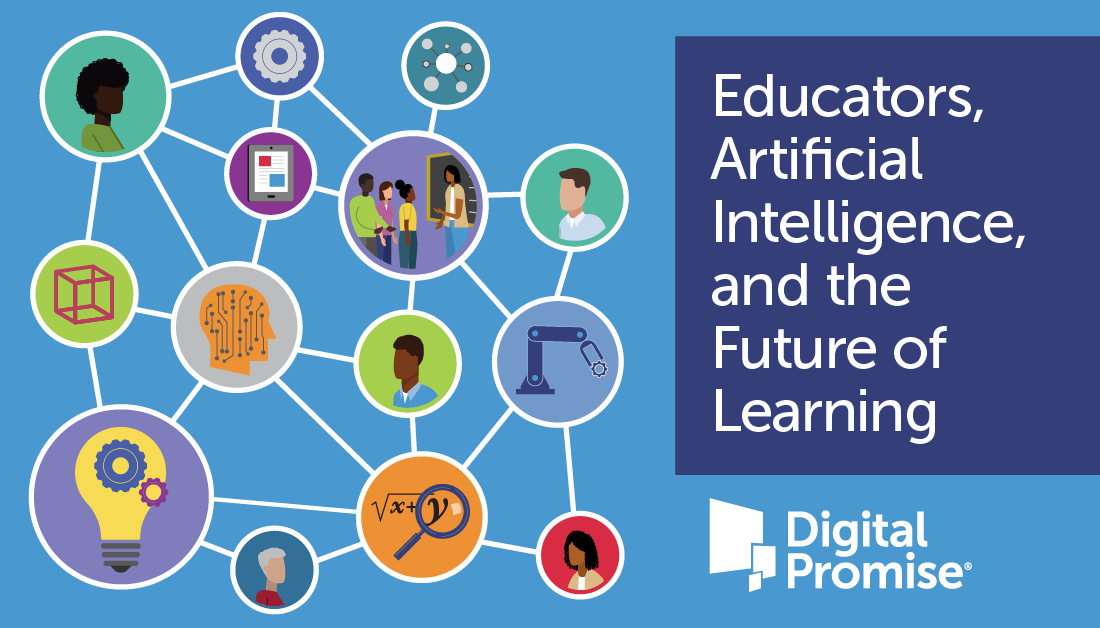
by Judi Fusco and Pati Ruiz
Artificial Intelligence (AI) systems are becoming more prevalent everywhere including education. Educators often seem to wonder, “What is it?” and, “What can it do?” Let’s address these questions and then discuss why and how YOU should be involved!
What is it and what can it do for teachers?
Artificial intelligence (AI) is a field of computer science that lets machines make decisions and predictions. The goal of AI is to create machines that can mimic human capabilities. To do this, AI systems use many different techniques. You are probably using AI systems every day because they are embedded in our mobile phones and cars and include things like face recognition to unlock your phone, digital voice assistants, and mapping/route recommendations. We’re not going to go into the details of how AI works in this post, but you can read a prior post on AI and check out this glossary of AI terms that might be helpful if you want more background on the topic. In this post, we will focus on examples of AI systems that can help teachers.
Teachers have to do countless tasks, such as lesson planning, teaching, grading mentoring, classroom management, keeping up with technology in the classroom and new pedagogical practices, monitoring progress, and administrative work, all while keeping students’ social and emotional needs in mind. While AI has come a long way since the 1950s when the term was coined and work on Intelligent Tutoring Systems began, it cannot replace a teacher in the classroom. We will share examples of how existing AI systems have successfully helped teachers and reduced their load.
Example: Personalized online math learning software for middle and high school students
Mathia provides coaching to students as they solve math problems and gives teachers a detailed picture of where each student is, as well as suggestions for conversation starters to talk about each student’s understanding. This support allows teachers to spend more time with students focused on learning, while also directly giving the students additional, useful feedback as they solve math problems.
Example: A platform that provides immediate feedback to students and assessment data to teachers
Another AI system that supports both teachers and students is ASSISTments. It is also currently focused on math. For students, it gives assistance in the form of hints and instant feedback while they do math homework. For teachers, it gives information about which homework problems were difficult and what the most common wrong answers were. This can prompt teachers to spend time discussing the problems that students need the most help on, and teachers can be sure to re-teach concepts based on common wrong answers.
In addition to teaching content, when you think about all the things a teacher does in managing their classroom and all the “plates” they must juggle to keep 25, 30, or more students on task, engaged, and learning, you can imagine they could use some support. These next three systems described primarily support teachers.
Example: A digital assistant for teachers
One AI system that helps with classroom management tasks is a multimodal digital assistant specifically developed for teachers with privacy in mind, called Merlyn. Merlyn looks like a small speaker, but does so much more. It allows teachers to use voice and a remote control to control content from a distance. For example, with Merlyn teachers can set timers and switch displays between their laptop, document camera, and interactive whiteboard. Teachers can control a web browser on their laptop and do things like share a presentation, go to a specific point in a video, show a website, or search. This frees them up to walk around the classroom and interact with students more easily.
Other ways AI systems can support teaching and learning
The examples above show three categories of how AI systems have helped teachers and their students. Three more examples include, an AI system that can analyze the conversation from a classroom session and identify the amount that a teacher talked versus a student (i.e. TeachFX). This tool also identifies whether teachers let students build on each other’s thoughts leading to discussions. With the help of this AI system, teachers can work to engage their students in discussions and reflect on their practice.
Grading is another task that is very important but very time consuming. Gradescope, for example, supports instructors in grading their existing paper-based and digital assignments in less time than it normally takes them. It does this by scanning text and sorting similar responses together for the teacher to grade some of each type, the system then “learns” from the teacher, automatically grades the rest, and sends the grading to the teacher for review.
Finally, AI systems that are specialized within a subject matter can allow teachers to set up content-specific learning experiences. For example in the domain of science, Inq-ITS, allows teachers to select digital labs for their middle school students. When completing the assigned digital labs, students learn by doing. Inq-ITS autoscores the labs in real-time and shows the teacher performance updates for each student. A teacher can use the reports to provide the appropriate support to students who need additional help. Inq-ITS also supports students with hints while performing the labs.
Educators Must be Involved in the Design of AI Systems
The AI systems described above, support or augment, but never replace a teacher. We believe that AI systems can help by doing things that machines are good at while having teachers do the things that humans do best.
The AI systems above are also designed by teams that have made education and learning environments the main audience for their systems. They have also included teachers in their design process. There are other AI tools that exist and even more that are being developed to support teachers and students on other activities and tasks, but some don’t have the same focus on education. We think that it’s important that in the design of AI systems for classrooms, educators – the end-users – need to be involved in the design.
Some of the teams that design AI systems for education haven’t been in a classroom recently and when they were they probably weren’t the teacher. To make a technology that works in classrooms requires classroom experts (the main users) to be part of the design process and not an afterthought. When teachers give feedback, they help ensure 1) that systems work in ways that make sense for classrooms in general, and 2) that systems would work well in their specific classroom situations. (We’ll discuss why this is the case in another future blog post.)
A final, yet very important reason for educators to be involved, is that while AI systems can bring opportunities to support teaching and learning, there are also privacy, ethics, equity, and bias issues to be aware of. We don’t want to add anything to your already full plate, but as technologies come into your classroom, you should ask questions about how the system supports students, if the systems were designed for students like your students, what the privacy policies are, and any implications that might affect your students.
We understand that most teachers don’t have a single extra minute but it is crucial to have current teachers in the design process. If you want to learn and think about AI systems, as they become more prevalent, you will become an even more invaluable teacher or technology leader in your school/district. Your voice is important and getting more educators involved makes a more powerful collective voice.
Looking ahead
If you’re still reading this blog, you probably have an interest in AI systems; below we suggest a few places to connect. Teachers are critical to the design of effective AI technologies for schools and classrooms. We hope this post has given you some insights into how AI systems might support you and your students. If you are interested in getting involved, we have some links for you below. Consider this blog post an invitation to you to connect with us and join the conversation; we hope you’ll join us in thinking about the future of AI in Education.
In our next post we will discuss how AI systems informed by learning science principles may help solve problems in learning environments.
Let us know your thoughts @educatorCIRCLS.
Ways to join:
Educator CIRCLS
AI CIRCLS
Join the ASSISTments Teacher Community
Leadership Programs — TeachFX

 Visions for how AI can support teachers and classrooms:
Visions for how AI can support teachers and classrooms: